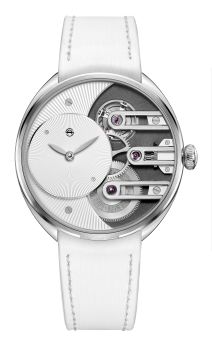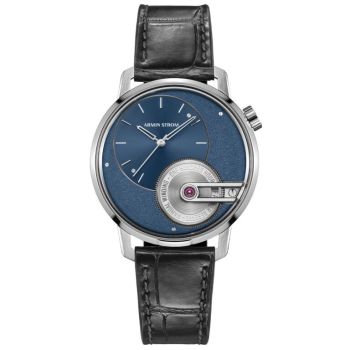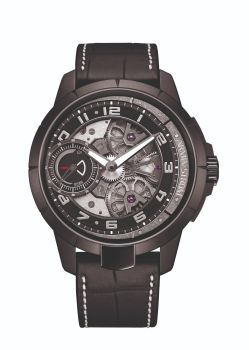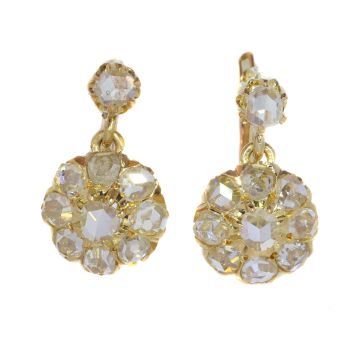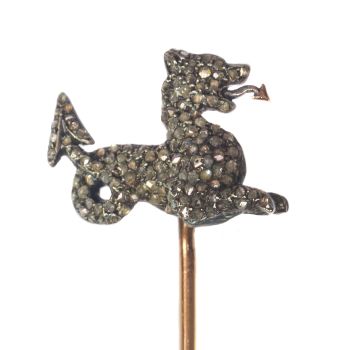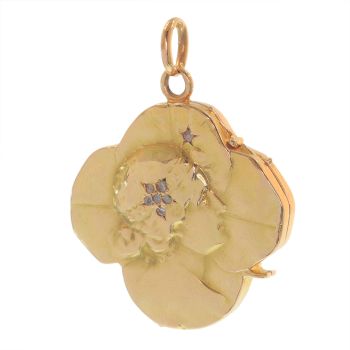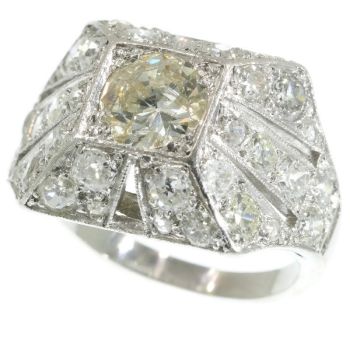Vintage Art Deco platinum ladies wrist watch made by Leon Hatot set with diamonds and sapphires 1920
Leon Hatot
DiamanteSafiraGemstonePlatina
Atualmente indisponível via Gallerease
- Sobre arte
Antique jewelry object group
ladies wrist watch
Condition
very good condition
more info on our condition scale
Country of origin
France
Style
Art Deco - Art Deco is an eclectic artistic and design style which had its origins in Paris in the first decades of the 20th century. The style originated in the 1920s and continued to be employed until after World War II. The term "art deco" first sawwide use after an exhibition in 1966, referring to the 1925 Exposition Internationale des Arts Décoratifs et Industriels Modernes that was the culmination of high-end style modern in Paris. Led by the best designers in the decorative arts such asfashion, and interior design, Art Deco affected all areas of design throughout the 1920s and 1930s, including architecture and industrial design, as well as the visual arts such as painting, the graphic arts and film. At the time, this style was seen aselegant, glamorous, functional and modern.
See also: Art Deco
more info on styles
Style specifics
Abstract motives and geometrical forms are quite typical for the Art Deco period. Art Deco moved away from the soft pastels and organic forms of its style predecessor, Art Nouveau, and embraced influences from many different styles and movements of the early 20th century, including Neoclassical, Constructivism, Cubism, Modernism,and Futurism. Its popularity peaked in Europe during the Roaring Twenties and continued strongly in the United States through the 1930s. Although many design movements have political or philosophical roots or intentions, Art Deco was purelydecorative.
Period
ca. 1920
Events & facts of this era, poetry of this era, fashion of this era.
Material
platinum (touchstone tested)
more info on precious metals
Extra information
Leon Hatot (1883-1953) Started in 1911, bought the atelier of Brédillard in Paris and was supplier to the important jewellery houses in quartier Vendôme and of René-Boivin.
Diamonds
Six old brilliant cut with an estimated weight of ± 0.48ct
112 single brilliant cut diamonds (also called 8/8)with an estimated weight of ± 2.00ct
Total diamond count
118 pcs.
Total diamond weight
approx. 2.48 crt with an average colour and clarity F/J, vs/i
All diamond weights, color grades and clarity are approximate since stones are not removed from their mounts to preserve the integrity of the setting.
All diamonds we offer are screened by the I.J.G.C. for whether they are natural or synthetic, and all diamonds in this jewel are 100% guaranteed to be natural.
Precious stones
48 sapphires
It is a very common practice to treat gemstones to intensify their clarity or colour. The item in question has not been tested in this regard.
Birthstones
Diamond is the birthstone (or month stone) for April and sapphire for September.
more info on birthstones
Hallmarks
Mastermark LH for Leon Hatot and the French control mark for platinum representing a dog's head that was in use in France from about 1912.
more info on hallmarks
Dimensions
width case 2,30 cm (0,91 inch)
see picture with a ruler in millimeters and inches
Weight
22,00 gram (14,15 dwt)
- Sobre artista
Léon Hatot (1883 – 1953) foi um empreendedor apaixonado: inventivo, inovador e acima de tudo progressista. Uma criança de seu tempo, na verdade, fascinada pela aplicação dos mais recentes materiais e técnicas.
O empresário e ourives Léon Hatot visitou a École d'Hologerie em Besançon de 1895 a 1898 e depois a École des Beaux Arts, também em Besançon. Ainda muito jovem, instalou-se em Besançon em 1905 como empresário independente e especializou-se na gravação de caixas de relógios.
Ele logo estabeleceu uma oficina para relojoeiros e joalheiros em Paris também. Aqui, auxiliado por um grande número de artesãos, ele fabricou relógios de alta qualidade, usando metais preciosos especiais. Naquela época, Hatot era um dos poucos a fabricar relógios e joias. Fornecia-os às casas comerciais mais importantes da Rue de la Paix, em Paris.
Curioso e de olho no futuro, Hatot logo se interessa pela aplicação da eletricidade em relógios. Em 1920, isso resultou no estabelecimento de um departamento para pesquisar e desenvolver relógios movidos a bateria. Desde 1923, os relógios elétricos Hatot são vendidos sob a marca ATO nos sites de Paris e Besançon.
A partir do momento em que esses relógios apareceram no mercado, eles foram um sucesso retumbante. Durante a 'Exposition international des arts décoratifs', Hatot foi premiado com um 'Grand Prix' por todo o seu programa de relógios elétricos. A característica de seus modelos era que eles eram alojados em mármore, metal cromado, madeiras refinadas ou caixas de vidro processado das famosas fábricas Lalique.
Por causa do design decorativo desses relógios, Hatot é capaz de estabelecer um nome no mundo do relógio como 'mestre do período Art Déco'. Sua contribuição para o mundo científico também é grande. Graças ao seu espírito criativo e visionário e às suas inúmeras invenções, Hatot conseguiu levar os desenvolvimentos no campo dos relógios a um nível superior até e incluindo o segundo quartel do século XX. A França recompensou-o por isso com o mais alto prêmio nacional, a 'Légion d'Honneur'.
Em 1931, na Exposição Colonial de Paris, Léon Hatot apresentou uma série de relógios elétricos compactos que marcaram o início de uma nova geração de relógios decorativos. Ele rompeu completamente com a tradição atual em que as caixas serviam de decoração e fez o próprio relógio chamar a atenção. Desta forma, Hatot tornou-se um criador de tendências para uma nova tendência da moda.
Artwork details
Related artworks
Onbekende Kunstenaar
Vroege Art Deco broche1920
Prijs op aanvraagAns Hemke-Kuilboer Juwelier & Antiquair
1 - 4 / 24Armin Strom
Armin Strom Lady Beat "Manufacture Edition White"2022 - 2023
Prijs op aanvraagHa-Juweliers
Armin Strom
Armin Strom Lady Beat "Manufacture Edition Black"2022 - 2023
Prijs op aanvraagHa-Juweliers
Armin Strom
Armin Strom "Gravity Equal Force Ultimate Sapphire"2022 - 2023
Prijs op aanvraagHa-Juweliers
Armin Strom
Armin Strom "Tribute 1 Stainless Steel Blue Dial"2022 - 2023
Prijs op aanvraagHa-Juweliers
Armin Strom
Armin Strom "Lady Beat Rosé Gold Mother of Pearl"2022 - 2023
Prijs op aanvraagHa-Juweliers
1 - 4 / 24- 1 - 4 / 24





































